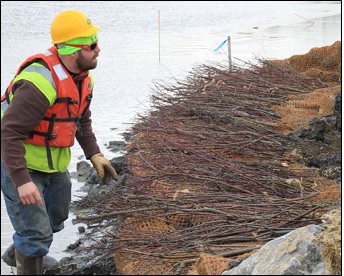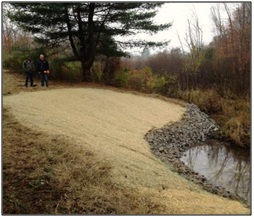Stream Corridor and Shoreline Protection

Stream corridors are complex ecosystems comprised of stream channels, their banks and riparian areas, and the plants and animals within them. Stream corridors and shorelines play an important role in providing unique and diverse habitat, flood protection, and water pollution attenuation. This section provides an overview of techniques used to restore stream corridors and shorelines where these important functions have been degraded by bank erosion and channel disruption that results in nonpoint sources of sediment and pollutants, flow alterations, and habitat disruption.
The most important factors for the success of stream restoration techniques are (1) a thorough understanding of stream processes and (2) an accurate assessment of current and future stream channel conditions (Brown, 2000). Stream corridors are dynamic, complex ecosystems that evolve with and in response to their watersheds. Each stream will normally function within natural ranges of flow, sediment movement, temperature and other variables, resulting in a stable channel size and form that is uniquely suited to those variables. Stable channels will maintain their form over time. Watershed land use changes that result in higher or lower flows can disrupt this stability when these variables go beyond a stream’s natural range (FISRWG, 1998). As a result, the stream can become degraded due to loss of channel form, bank erosion, habitat loss, and other adverse impacts to ecosystem and societal values. Watershed land use changes that typically impact the stability of a stream include land clearing and development, which can increase the volume, rate, and temperature, and degrade the water quality of runoff. Altered rainfall patterns and other impacts of climate change will similarly affect stream channel stability when the carrying capacity of a stream channel is exceeded by large rainfall amounts, for example.

In addition to runoff-related impacts, Massachusetts streams are also impacted by dam removal or construction and related flow alterations, and the removal of vegetation from stream riparian areas and banks. In response to these impacts, many streambanks have been "stabilized" w ith riprap, concrete or masonry sidewalls and channel bottoms. Although these approaches may halt erosion at that location, they generally contribute to the degradation of other important stream functions such as aquatic habitat. Also, these approaches often merely relocate the erosion problem downstream and/or to the opposite bank.
Due to the complexity of factors affecting watershed stability and stream corridor restoration, a qualified professional should be engaged to assist with this work. The first step in designing any stream restoration project should be to determine what the project goals are within the context of the stream’s current condition and the watershed land uses that contributed to the condition. Once this is understood, the next step is to determine the appropriate techniques to either restore the stream by (1) removing the cause of degradation or (2) restoring natural functions and processes within the context of the disturbance.
Streambank and Shoreline Restoration Resources
Stream Corridor Restoration-Principles, Processes and Practices (Federal Interagency Stream Corridor Restoration Working Group, 1998. Revised 2001). Produced collectively by 15 U.S. federal agencies, this document provides a comprehensive discussion of steam corridor restoration principles and techniques.
http://www.nrcs.usda.gov/wps/portal/nrcs/detailfull/national/water/?cid=stelprdb1043448
The Massachusetts Buffer Manual: Using Vegetated Buffers to Protect Our Lakes and Rivers (Berkshire Regional Planning Commission, 2003)
http://www.mass.gov/eea/docs/dep/water/bufin2.pdf
Ecological Restoration: A Tool to Manage Stream Quality (EPA 841-F-95-007, November 1995). This manual describes how stream quality can often be managed by using restoration techniques in conjunction with more traditional management approaches, such as point source permitting.
http://water.epa.gov/type/watersheds/archives/ecology_index.cfm
Fact Sheets on Functions and Values of Riparian Areas: A series of nine fact sheets prepared by Russ Cohen of Massachusetts Riverways Programs.
http://www.mass.gov/eea/agencies/dfg/der/publications/technical-resources/
Massachusetts River and Stream Crossing Standards (Massachusetts River and Stream Continuity Partnership, revised March 1, 2011)
http://www.nae.usace.army.mil/Portals/74/docs/regulatory/StreamRiverContinuity/MA_RiverStreamCrossingStandards.pdf
Massachusetts Stream Crossings Handbook (Massachusetts Riverways Program, Second Edition, June 2012)
http://www.mass.gov/eea/docs/dfg/der/pdf/stream-crossings-handbook.pdf
List of Native Plant Species Suitable for Planting in Riparian Areas in Massachusetts, prepared by Russ Cohen of Massachusetts Riverways Programs:
http://www.mass.gov/eea/docs/dfg/der/riverways/native-riparian-species.pdf
A Shoreland Homeowner’s Guide to Stormwater Management, prepared by the New Hampshire Department of Environmental Services.
http://des.nh.gov/organization/commissioner/pip/publications/wd/documents/nhdes-wd-10-8.pdf
Vegetated Buffer Strips: Slow the Flow to Protect Water Quality (MassDEP, 2001). This brochure includes tips for establishing vegetated buffer strips to protect water quality.
http://www.mass.gov/eea/agencies/massdep/water/watersheds/vegetated-buffer-strips-slow-the-flow.html
Massachusetts Erosion and Sediment Control Guidelines for Urban and Suburban Areas: This manual is designed to provide background information to the general public who may be involved in projects affecting land and water resources in Massachusetts. Web link:
http://www.mass.gov/eea/docs/dep/water/essec1.pdf
Riparian Buffers for the Connecticut River Valley: An excellent collection of fact sheets on riparian buffers prepared by the Connecticut River Joint Commissions.
http://www.crjc.org/riparianbuffers.htm
Vermont Department of Environmental Quality, River Management Section: The following link provides access to a variety of resources for river and stream restoration and assessment:
http://www.vtwaterquality.org/cfm/ref/Ref_Rivers.cfm
Massachusetts Programs for Stream Restoration
Massachusetts Division of Ecological Restoration (DER): DER has developed several programs, listed below, to meet the needs of river advocates and river resources.
http://www.mass.gov/dfwele/river
- River Continuity Program: River Continuity works to reduce impediments to movement of fish, wildlife and other aquatic life that require instream passage. The River Continuity Partnership is a collaborative effort with DER, the University of Massachusetts Extension, The Nature Conservancy, and other nonprofit and agency partners. http://www.mass.gov/eea/agencies/dfg/der/aquatic-habitat-restoration/river-restoration/river-continuity-program.html
- Stream Teams: Stream Teams provide on-going stewardship for a stream for at least a year. Over 100 groups have been started, and many have gone on to become watershed associations with large river constituencies. Stream Teams work locally to protect and restore the streams in their community. In many communities, Streams Teams play an integral role in protecting natural resources and in working with conservation commissions to create active citizen participation. http://www.mass.gov/eea/agencies/dfg/der/technical-assistance/stream-teams.html
- Urban River Revitalization: In 1996, the Massachusetts Riverways Program established a program focusing on Urban Rivers, championing the potential of these often overlooked waterways and promoting their value as natural resources in the midst of a built environment. Urban Rivers has since been folded into the DER Restoration unit. Urban River Projects may now be nominated to become a DER Priority Project. If selected, DER can provide resources to help a community address the unique challenges and varied needs of their urban waterway to help plan and achieve an appropriate level of restoration and urban revitalization. http://www.mass.gov/eea/agencies/dfg/der/aquatic-habitat-restoration/river-restoration/urban-river-revitalization.html
Massachusetts Rivers Protection Act: This law creates a 200-foot riverfront area that extends on both sides of rivers and streams. In certain urban areas, the riverfront area is 25 feet. The purpose is to protect water quality, preserve wildlife habitat, and controlling flooding. The Rivers Protection Act is promulgated through municipal Conservation Commissions under the Massachusetts Wetlands Protection Act permitting process.
http://www.mass.gov/eea/agencies/massdep/water/regulations/massachusetts-rivers-protection-act-about.html
Section 319 Nonpoint Source Pollution Grant Program: Section 319 of the Clean Water Act of 1987 established a national program to control nonpoint sources of pollution. Each year the Massachusetts DEP issues a Request for Responses (RFR) for competitive projects to be funded through Section 319 grants. Funding from this program can be used streambank restoration projects to address erosion and other NPS problems.
http://www.mass.gov/eea/agencies/massdep/water/grants/watersheds-water-quality.html#2
Best Management Practices for Stream Corridor Restoration

Stream corridor restoration involves both "in-stream" restoration and the restoration of streambanks and riparian buffers. The stream corridor restoration techniques described in this section also generally fall into two major categories:
Structural Systems include techniques such as tree revetments, gabions, boulder clusters, wing deflectors, and log, rootwad, and boulder revetments. These structural systems are usually used to resist and/or re-direct erosive forces, or to provide grade control and habitat enhancement. These systems must be designed and installed by a qualified expert.
Vegetative Systems include a variety of planting approaches such as live fascines, vegetated geogrids, live stakes, and riparian forest buffers. These practices are used to stabilize and trap eroding soils along streambanks and shorelines, and to provide riparian habitat, shading, and other benefits.
Fact Sheet Links
References
KSCC. Kansas River and Stream Corridor Management Guide. Kansas State Conservation Commission.
http://www.kaws.org/files/kaws/KSRiversGuide.pdf
Riley, A. L. 1998. Restoring Streams in Cities: A Guide for Planners, Policymakers and Citizens. Island Press. Washington, DC.
Brown, Kenneth. 2000. Urban Stream Restoration Practices. An Initial Assessment. The Center for Watershed Protection. Elliot City, MD.
http://www1.villanova.edu/content/dam/villanova/engineering/vcase/sym-presentations/2001/B11.pdf
FISRWG. 1998. Federal Interagency Stream Restoration Working Group. Stream Corridor Restoration - Principles,, Processes and Practices.
http://www.nrcs.usda.gov/wps/portal/nrcs/detailfull/national/water/?cid=stelprdb1043448
LCSMC and USDA-NRCS. 2002. Streambank and Shoreline Protection Manual. Lake County (Illinois) Stormwater Management Commission and USDA-NRCS.
http://www.lrc.usace.army.mil/Portals/36/docs/regulatory/pdf/StrmManual.pdf
Massachusetts Erosion and Sediment Control Guidelines for Urban and Suburban Areas. 1997. Prepared by Franklin, Hampden, Hampshire Conservation Districts for Massachusetts EOEA and Massachusetts DEP, Northampton, MA.
http://www.mass.gov/eea/docs/dep/water/essec1.pdf
US-EPA Watershed Academy. Fundamentals of the Rosgen Stream Classification System.
www.epa.gov/watertrain/stream_class
Cohen, Russ. 1997. Massachusetts River Fact Sheets. Massachusetts Riverways Program.
http://www.mass.gov/eea/agencies/dfg/der/publications/technical-resources/